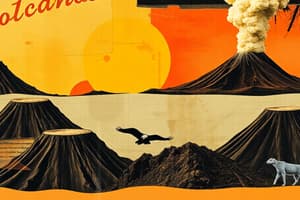Podcast
Questions and Answers
What type of volcano is characterized by gentle slopes and a broad base?
What type of volcano is characterized by gentle slopes and a broad base?
- Shield Volcano (correct)
- Stratovolcano
- Cinder Cone
- Caldera
What is the term for areas of the Earth's surface covered with numerous small volcanoes and volcanic vents?
What is the term for areas of the Earth's surface covered with numerous small volcanoes and volcanic vents?
- Volcanic Arc
- Hotspot
- Volcanic Field (correct)
- Lava Plateau
What process involves the melting of the Earth's mantle to form magma?
What process involves the melting of the Earth's mantle to form magma?
- Volcanic Arc Formation
- Magma Generation (correct)
- Volcanic Eruption
- Magma Ascent
What type of volcano forms underwater, often at the edges of tectonic plates?
What type of volcano forms underwater, often at the edges of tectonic plates?
What is the term for a large depression formed by the collapse of a volcano following a massive eruption?
What is the term for a large depression formed by the collapse of a volcano following a massive eruption?
What process involves the rise of magma through the crust to reach the surface?
What process involves the rise of magma through the crust to reach the surface?
What is the term for a chain of volcanoes formed by the subduction of an oceanic plate beneath a continental plate?
What is the term for a chain of volcanoes formed by the subduction of an oceanic plate beneath a continental plate?
What is the term for areas of volcanic activity that occur at the surface of a tectonic plate, often forming a chain of volcanoes?
What is the term for areas of volcanic activity that occur at the surface of a tectonic plate, often forming a chain of volcanoes?
Flashcards are hidden until you start studying
Study Notes
Types of Volcanoes
- Shield Volcanoes: Gently sloping volcanoes with a broad base and a flat or rounded top, formed by the eruption of fluid lava flows.
- Stratovolcanoes: Tall, conical volcanoes composed of alternating layers of lava, ash, and other pyroclastic material, formed by a combination of lava flows and explosive eruptions.
- Cinder Cones: Small, steep-sided volcanoes formed by the accumulation of ash and cinder from small-scale eruptions.
- Calderas: Large depressions formed by the collapse of a volcano following a massive eruption, often filled with water to form a lake.
- Submarine Volcanoes: Volcanoes that form underwater, often at the edges of tectonic plates.
Volcanic Landforms
- Volcanic Fields: Areas of the Earth's surface covered with numerous small volcanoes and volcanic vents.
- Lava Plateaus: Large areas of flat or gently sloping land formed by the accumulation of lava flows.
- Volcanic Arcs: Chains of volcanoes formed by the subduction of an oceanic plate beneath a continental plate.
- Hotspots: Areas of volcanic activity that occur at the surface of a tectonic plate, often forming a chain of volcanoes as the plate moves over a fixed magma source.
Volcanic Formation
- Magma Generation: The process by which magma is formed from the melting of the Earth's mantle, often triggered by the movement of tectonic plates.
- Magma Ascent: The process by which magma rises through the crust to reach the surface, driven by its buoyancy and pressure.
- Volcanic Eruption: The process by which magma is released from the surface, often explosively, resulting in the formation of volcanic landforms.
- Volcanic Arc Formation: The process by which volcanic arcs are formed, involving the subduction of an oceanic plate and the resulting melting of the mantle to produce magma.
Types of Volcanoes
- Shield volcanoes have a gently sloping shape with a broad base and a flat or rounded top, formed by fluid lava flows.
- Stratovolcanoes are tall, conical, and composed of alternating layers of lava, ash, and other pyroclastic material, formed by both lava flows and explosive eruptions.
- Cinder cones are small, steep-sided volcanoes formed by the accumulation of ash and cinder from small-scale eruptions.
- Calderas are large depressions formed by the collapse of a volcano following a massive eruption, often filling with water to form a lake.
- Submarine volcanoes form underwater, often at the edges of tectonic plates.
Volcanic Landforms
- Volcanic fields are areas covered with numerous small volcanoes and volcanic vents.
- Lava plateaus are large areas of flat or gently sloping land formed by the accumulation of lava flows.
- Volcanic arcs are chains of volcanoes formed by the subduction of an oceanic plate beneath a continental plate.
- Hotspots are areas of volcanic activity that occur at the surface of a tectonic plate, often forming a chain of volcanoes as the plate moves over a fixed magma source.
Volcanic Formation
- Magma generation occurs when magma is formed from the melting of the Earth's mantle, often triggered by tectonic plate movement.
- Magma ascent is the process by which magma rises through the crust to reach the surface, driven by buoyancy and pressure.
- Volcanic eruptions occur when magma is released from the surface, often explosively, resulting in the formation of volcanic landforms.
- Volcanic arc formation involves the subduction of an oceanic plate and the resulting melting of the mantle to produce magma.
Studying That Suits You
Use AI to generate personalized quizzes and flashcards to suit your learning preferences.




